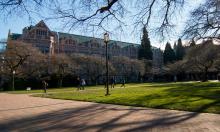See the main Geography IT page for details about lab hours and policies.
John Sherman Cartography and GIS Laboratory – Smith 401
The legacy of John C. Sherman is memorialized in the Sherman Cartography and GIS Laboratory, as a reminder of his lasting contribution to cartography, to the Geography Department and to the University of Washington. John Sherman was founder of the modern cartography program at the university, the first full time cartographer at any American university, and for over three decades one of the leading cartographers in the country. John Sherman came to the University of Washington in 1939 as a teaching fellow, and promoted to instructor in 1943. After completing his doctoral dissertation in 1947 with a specialty in climatology, he was appointed as Assistant Professor. He was promoted to Associate Professor in 1954 and to Full Professor in 1963. Between 1963 and 1973 he served as the departmental chairman. He retired in 1986. The geography department at University of Washington on June 5, 1987 renamed the cartography room the Sherman Laboratory.
The Sherman Laboratory was partially converted to a computer-based facility in 1987, and fully converted to a computer-based facility in 1991. A course, curriculum and laboratory instruction grant supported acquisition of 25 workstation tables on roller castings that are still in use today. Over the past two decades, about every three years, the computer workstations, now numbering 30, are replaced with state-of-the-art computers to keep pace with research and instruction performance needs for the lab. A digital projector enables display on an over-sized display screen connected to a chauffeured workstation. All computers are connected to Geography data servers and to the University network through high performance cabling.
The Sherman Lab supports student research activity during the drop-in open hours of the lab. Undergraduates and graduates from Geography make use of the space. In the evenings, the Lab supports the Professional and Continuing Education GIS Certificate Program offerings.
Edwin Ullman Collaboratory – Smith 415C
The legacy of Edwin Ullman is memorialized in the Ullman Collaboratory, as a reminder of his contribution to the Geography Department and to the University of Washington. In 1951, the UW Libraries entered into a memorandum of agreement with the Geography Department, at the encouragement of the then Chair of the Geography Library Committee, Edwin Ullman. The UW Libraries, together with Geography, offered library services in Smith 415 until in the early 1990’s, when the Geography Library book and journal collection was moved from Smith Hall to Suzzallo main library as a cost-cutting activity. Once the books were transferred, the Edwin Ullman Collaboratory was created by transferring the space to Geography.
A design was implemented with funds from the National Science Foundation in cooperation with the University of Washington Libraries to offer a face-to-face group/team work space for research and instruction activity. Faculty and students alike mentor each other in this space where students work in teams, to solve problems and create images. The space contains six tables at which six students could be seated for discussion about map visualizations and other materials on large-screen monitors. The Collaboratory includes a chauffeured workstation in the middle of the space that drives a digital projector for wall-size display. All computers are connected to Geography data servers and to the University network through high performance cabling.
The Collaboratory is often used for student group research work, when not being used for instruction. Research teams frequent the space because of the larger computer displays and discussion tables that it offers. Students are often exposed to the space during classroom instruction , wherein the digital projector wall is used for conveying important points viewed by all class participants to help foster discussion.
